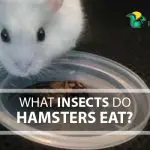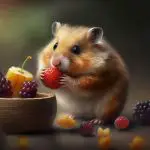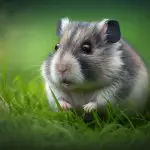What Can Hamsters Eat and Can’t Eat?
A healthy diet goes a long way in ensuring your pet Hamster stays healthy and active. However, it’s sometimes hard for pet owners to decide which food to feed their pets since some are healthy while others are not.
So, what can a hamster eat and can’t eat? A hamster can eat pellets, seed mixes, vegetables, fruits, and occasionally healthy treats. They require a balanced diet with proteins, carbohydrates, fats, and fiber. Avoid feeding your pet synthetic sugars, which can cause obesity and diabetes.
Like humans, what you feed hamsters impacts their health and lifespan. To be safe, read on to know the safe foods and the toxic ones to avoid.
What Is A Hamster’s Diet Requirement?
In the wild, hamsters enjoy feeding on vegetables, roots, nuts, and ants for their protein diet. They also eat some fruits for their sweet tooth, which include mangos.

Most captive hamsters eat store-bought food mixes that contain most of the diet in one serving. However, some pelleted foods are high in fat, which can harm their health and should be mixed.
Before learning what your pet can eat, first you should know what they require in their diet. The table below summarizes the percentage of different things your pet needs in their diet.
| Diet | Amount |
|---|---|
| Proteins | 20% |
| Carbohydrates | 40% |
| Fat | 5% |
| Crude fiber | 5% |
If you can provide your pet hamster with the above dietary requirements, you will escape illnesses and frequent visits to a vet. This will ultimately lead to a long and fulfilling life for your vibrant hamsters.

What Can A Hamster Eat?
Hamsters can eat various plant-based foods and fruits that humans enjoy eating. An easy choice is feeding them pellet food which has a balanced diet. Most pellets are small and cone-shaped, which is easy for pet hamsters to eat and stuff into their cheek pouches.
An advantage of a pellet diet is that your pet hamster cannot select individual foods from them. In other diets, the pets can pick and eat the sweeter food of the mixture. However, pellets should be mixed with other sweet food choices like fruits and vegetables.

The other option involves mixing different foodstuffs to make a healthy diet. You can mix vegetables, seeds, nuts, proteins, and fruits, among other choices.
1. Vegetables
Vegetables are a great source of nutrients and vitamins for your pet hamster. They contain vitamins A, C, folate, and potassium, which your pet rodent needs. Some vegetables your pets can enjoy include:
- Raw spinach
- Dandelion greens
- Carrots
- Cauliflower
- Cucumber
- Peas
- Squash
- Cucumber
- Cress
- Chicory
- Broccoli
2. Fruits
Fruits are a source of minerals and vitamins and are high in fiber. They also contain antioxidants, like flavonoids which can boost your pet rodent’s health. Some of the fruits your pet can like include:

- Apples (Avoid apple seeds)
- Bananas
- Melons
- Pear
- Peach
- Grapes
- Berries
3. Proteins
As omnivores, hamsters require an animal-based diet as a source of proteins to them. Some of the animal-based diets they can enjoy include;
- Cricket
- Mealworms
- Chicken (without spices)
- Turkey (without spices)
- Scrambled eggs
- Boiled egg
- Low-fat cheese
4. Nuts
Nuts are healthy treats you can occasionally serve your pet hamster. Some types of nuts they can enjoy include;
- Walnuts
- Almonds
- Pine nuts
- Brazil nuts
- Cashew nuts
5. Seeds
Seeds contain healthy fats and are a great source of fiber for your pet. Some of the seeds to serve your pet include;
- Sunflower
- Flax
- Sesame
- Corn kernels
- Wheat seeds
- Pumpkin
Your hamster will rarely have a problem feeding any of the above foods. They may only seem to prefer some foods to others. You only need to ensure you balance their diet to avoid overfeeding them with one type of food.
How to Feed A Hamster?
Feeding a hamster is straightforward, especially when serving them store-bought pelleted food. However, to ensure they have a balanced diet, there are things to observe.

- Before providing your pet hamster with its vegetables and fruits, remember to wash them
- Also, when buying them, ensure they’re organic to clean out pesticides. With their small size, even tiny amounts of pesticide may harm their health
- You can mix 2 to 3 types of seeds for a healthier diet for your pet. Also, mix them with vegetables for a balanced diet
- Your mixture can include nuts but remember they should only be served as an occasional treat
- Also, remove nuts from the shells to minimize the risks of choking
- Do not serve salt or salted foods because the high sodium can cause them to dehydrate faster

Below are the simple steps you should follow when feeding your pet.
- Place the ideal amount of the food mixtures in the pet’s bowl
- Put the food in their feeding location
- Add some water to the water bottle or bowl
- Likewise, provide the food in the evening since these pets are nocturnal and eat at night.
- You can make feeding interesting by scattering some of the pellets so that your pet corrects them. Hiding treats is also good as it works better for the pet.
- Remember to offer your pet fresh or filtered water every day. The water would help in their digestion, especially if your pet ate a lot of dry foods. Also, water helps your pet stay hydrated.
- Also, remember pets with a condition like pregnancy may require a diet rich in some nutrients. Consult with a veterinarian on these occasions to ensure your pet is feeding on the ideal food.
- Remove any food not eaten within 12 hours from the cage because they spoil after that time. Pet hamsters spill some food when eating which is why it’s best to clean regularly.

While still on the topic of eating, hamsters require things to chew besides food. Some are for entertainment and fun, while others help avoid teeth malocclusion, which is common in these rodents.
- Provide your pet hamster with some materials to chew and gnaw on. They can chew cardboard, hay cubes, and seagrass to keep their teeth healthy. Also, some woods like dogwood, elm, hazelnut, Quince, or Yucca, can make a good gnawing material.
How Much Food Should A Hamster Eat?
Hamsters are hoarders and opportunistic feeders, which reflects their instincts. They can hide some foods in the burrows to eat later and beg their owners for more.
- Pellets and seeds are the main diet and should make up 60% – 70% of the main dish.
- Fruits and vegetables can then follow up as additional with at least 20%.
- Other treats should range between 5% and 10% of the total diet.
- Nuts are occasional treats that you can serve in 2-4 pieces per month.
- Other treats, especially those high in sugar, like fruits, should be served once per week too.

Most pelleted foods have instructions on the amount your pet should take.
- However, Hamsters should take at least 1/8 or 1/3 of a cup of pelleted food daily.
Veterinarians can help you determine the amount to feed your pet if you’re unsure. They can measure your pet’s weight and determine the amount safe for its consumption.
- Animal-based foods should be served after every few days or two times a week. This is to ensure that the pet concentrates on healthier foods like pellets or vegetables and less on treats.
- While seeds make a good bite-sized snack for the pet, they can be a health hazard if eaten in large amounts. Some are high in fat which can promote conditions like obesity. Avoid overfeeding the pet with a seed diet.
What Can A Hamster Not Eat?
Some foodstuffs are unhealthy for the pet and can affect its health negatively. For instance, Apple seeds contain toxic cyanide, which can negatively affect your pet’s health.

Some other foods that may cause health problems include
Citrus fruits
Citrus fruits like oranges, lemons, and grapefruits are very acidic, which can cause diarrhea to your pet rodent.
Chocolate
Alkaloid theobromine which is naturally in the cocoa plant that makes chocolate, can cause problems like chocolate toxicosis.
Onions
Onions have a substance, N-propyl disulfide, which can affect your pet’s red blood cells.
Bitter Almonds
Bitter almonds have a high amount of cyanide which may cause Cyanide poisoning and kill your hamster if ingested. However, they can eat sweet almonds.
Raw Potatoes
Potatoes are high in starch, which can cause diarrhea in your pet hamster.
Raw beans
Like potatoes, the high starch in beans can cause diarrhea and, in the worst-case, dehydration.
Peanuts
Peanuts may contain aflatoxins which can negatively impact your pet’s health if ingested.
Celery
The stringy nature of celery makes it dangerous for consumption by the pet hamster. It can choke the pet and probably kill it.
Tomato leaves or stems
Tomatoes are acidic, and despite being okay for the pet to eat too much can affect it. Also, if the pet eats the stems and leaves, it can die.
Caffeine
A hamster’s heartbeat is quick and ranges between 10 and 15 beats every second. Caffeine may increase the heartbeat, which can risk heart diseases like cardiac arrest.
Also, food bought in bulk loses freshness and nutrients over time. Therefore, avoid feeding your pet stored foods. This helps you minimize the risk of losing your hamster to issues like food poisoning.

FAQs
The following section contains questions most hamster owners have frequently asked about their pets feeding.
Q: Do all Hamster Species Eat the Same Foods?
Most hamster species feed the same kind of foodstuff, like pelleted seeds. The only difference is in the amount the pets may eat, with the dwarf hamsters eating a little less than Golden hamsters.
Q: Why is my Hamster not Feeding?
There are many reasons your hamster may not be feeding, including sickness and stress. Though rare, the pet may also be full from eating the food it may have hidden in its burrows. To be sure, take the pet to a veterinarian.
Q: Can Hamsters Eat Human Foods?
Pet hamsters can enjoy some of the foods we eat as long as they are not seasoned. They can enjoy breakfast cereals or grains if they’re sugarless. However, serving them their dedicated food for a healthier diet is best.
Bottom Line
Hamsters are fluffy adorable pets that sometimes the owners get confused about what to feed them. They’re not expensive to feed since they only eat tiny portions daily. However, the question with most owners is, what can hamsters eat and can’t eat?
The list of okay foods is large and only requires moderation when serving the pet. Too much can end up affecting the pet negatively rather than providing nourishment. Also, every Hamster owner should observe the list of foods to avoid and keep off it.




